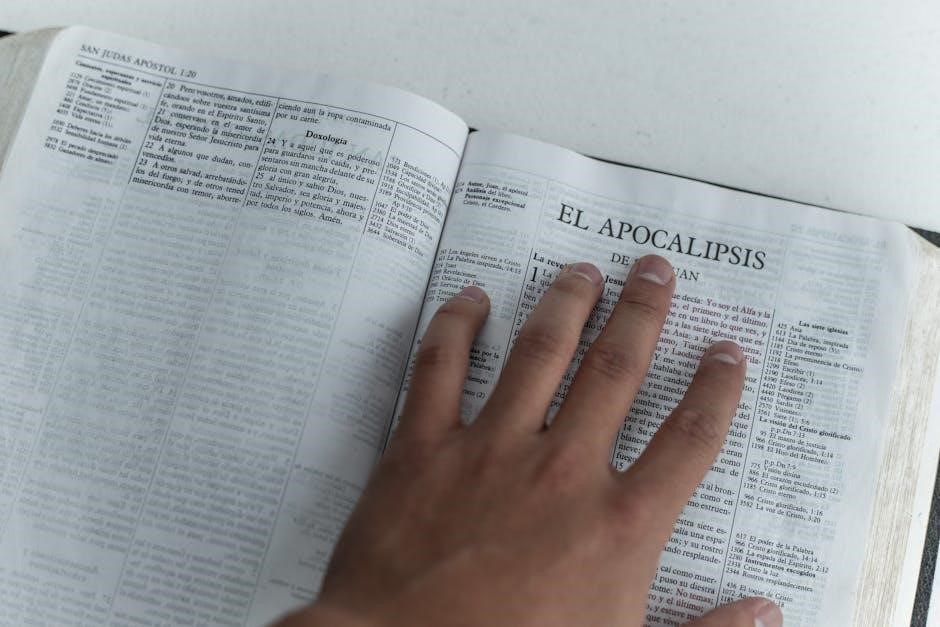The Book of Revelation, the New Testament’s final book, explores themes of hope, judgment, and redemption through symbolic visions, offering profound spiritual insights and guidance․
Overview of the Book and Its Significance
The Book of Revelation, often called the Apocalypse, is a profound text rich in symbolism and apocalyptic imagery․ It serves as a culmination of biblical themes, offering hope, warning, and divine judgment․ This book is deeply significant as it provides insights into God’s ultimate plan for humanity, emphasizing redemption and eternal triumph over evil․ Its complex visions and metaphors have inspired countless interpretations, making it a cornerstone of Christian eschatology and a source of spiritual reflection for centuries․ Understanding its context and symbolism is essential for grasping its message of hope and the promise of Christ’s return․
Historical Context of the Book of Revelation
The Book of Revelation was written during a time of intense persecution for early Christians, likely under Emperor Domitian’s rule in the late 1st century AD․
The Authorship and Date of Composition
The Book of Revelation is traditionally attributed to John of Patmos, often identified as the Apostle John, though debates about authorship persist․ Most scholars date its composition between 90-95 AD, during Emperor Domitian’s reign, a period of intense persecution for early Christians․ This late 1st-century context aligns with the book’s themes of endurance and hope amidst suffering․ The text addresses seven churches in Asia Minor, offering both encouragement and correction; The historical setting of political oppression and religious turmoil shapes the book’s apocalyptic imagery and its call to remain faithful in the face of adversity․
Literary Structure of the Book of Revelation
The Book of Revelation is structured around letters to seven churches, a throne room vision, and apocalyptic imagery, progressing from judgment to ultimate redemption and hope․
The Letters to the Seven Churches and the Throne Room Vision
The Book of Revelation begins with letters to seven churches in Asia, offering encouragement, correction, and a call to remain faithful amidst persecution․ These letters, dictated by Christ, address spiritual strengths and weaknesses, urging believers to repent and persevere․ Following this, the throne room vision in Revelation 4-5 presents a celestial scene of worship, emphasizing God’s sovereignty and the Lamb’s worthiness to open the seven seals․ This dual focus on earthly churches and heavenly realities underscores the connection between spiritual warfare and eternal hope, setting the stage for the apocalyptic events that unfold․
Major Themes in the Book of Revelation
The Book of Revelation explores eschatology, judgment, redemption, and spiritual warfare, emphasizing God’s sovereignty, Christ’s victory, and the ultimate triumph of good over evil․
Eschatology, Judgment, and the Return of Christ
The Book of Revelation profoundly explores eschatology, detailing the end times, final judgment, and Christ’s triumphant return․ It vividly describes the Second Coming, resurrection, and the establishment of God’s eternal kingdom․ Symbolic imagery, such as the Second Coming as a thief in the night and the wedding of the Lamb, underscores the urgency and glory of these events․ The book emphasizes divine justice, separating the righteous from the wicked, and culminates in a new heaven and earth․ These themes inspire hope, call believers to fidelity, and remind all of God’s ultimate victory over evil and death;

Symbolic Imagery in the Book of Revelation
The Book of Revelation is rich in symbolic imagery, including the Lamb, the Beast, and the New Jerusalem, which convey spiritual truths and divine judgment․
Understanding the Seven Seals, Trumpets, and Bowls
The Book of Revelation unfolds a sequence of divine judgments through the Seven Seals, Trumpets, and Bowls․ The Seven Seals symbolize Christ’s authority over history, revealing conquest, conflict, famine, and death․ The Seven Trumpets announce judgments on the earth, including plagues and cosmic disturbances․ Finally, the Seven Bowls represent the ultimate outpouring of God’s wrath, targeting those who oppose His rule․ These symbolic series emphasize divine justice, urging believers to remain faithful amidst turmoil․ Each phase escalates in intensity, culminating in Christ’s triumphant return and the establishment of His eternal kingdom․

Key Figures in the Book of Revelation
Central figures include Jesus Christ as the Lamb, symbolizing redemption, and the Beast, representing evil opposition․ The 144,000 sealed believers, the Two Witnesses, the Whore of Babylon, and the Dragon also play pivotal roles in the divine conflict and ultimate triumph of God’s kingdom․
The Role of Jesus Christ, the Lamb, and the Beast
Jesus Christ, as the Lamb, is central to Revelation, symbolizing redemption and divine authority․ The Lamb’s sacrifice and resurrection underscore God’s plan for salvation․ In contrast, the Beast represents evil’s embodiment, opposing God and persecuting believers․ The conflict between the Lamb and the Beast highlights the cosmic struggle between good and evil․ The Lamb’s ultimate triumph over the Beast signifies God’s victory and the establishment of His eternal kingdom․ These figures embody the spiritual warfare and redemption themes, offering hope to believers in their perseverance and faith amidst tribulation․

The Apocalyptic Genre and Its Interpretation
The apocalyptic genre is rich in metaphors and visions, conveying spiritual truths through dramatic imagery․ It aims to inspire hope and resilience, urging believers to remain faithful amidst challenges․ Its interpretation often requires understanding historical context and symbolic language, offering timeless relevance for modern readers․
Historical Context and Modern Applications
The Book of Revelation was written during a time of intense persecution under Emperor Domitian (AD 90–95), addressing early Christian communities facing severe trials․ Its symbolic language, such as the depiction of the beast and Babylon, served as veiled critiques of Roman oppression while offering comfort and hope to believers․ Today, its themes of spiritual warfare, trust in God’s sovereignty, and the promise of eternal redemption remain deeply relevant․ Modern readers apply its teachings to navigate personal and global challenges, emphasizing faith, love, and endurance in the face of adversity, inspiring transformation and steadfast commitment to Christ․

Interpretations of the Book of Revelation
The Book of Revelation is interpreted through various lenses, including Preterism (past fulfillment), Futurism (future events), and Idealism (timeless truths)․ Each approach offers unique insights into its apocalyptic visions and spiritual significance․
Preterism, Futurism, and the Idealist Approach
Preterism interprets Revelation as largely fulfilled in the 1st century, linking events to Rome’s fall․ Futurism views the book as prophecy of future end-times․ The Idealist approach sees it as timeless truths about God’s sovereignty․ These frameworks guide readers in understanding symbolic imagery and apocalyptic themes, helping to apply the book’s message to their lives․ Each perspective offers unique insights, enriching the study of Revelation’s complex and deeply symbolic text․
Practical Application of the Book of Revelation
The Book of Revelation encourages believers to live with eternity in view, trusting God’s sovereignty amid trials, and engaging in spiritual warfare with faith and perseverance․
Living in Light of Eternity and Spiritual Warfare
Revelation calls believers to live with eternal perspective, prioritizing God’s kingdom over temporary comforts․ It emphasizes trust in divine sovereignty, enduring trials with faith, and engaging in spiritual battles through prayer and obedience․ The book underscores the importance of remaining vigilant against spiritual deception and steadfast in one’s commitment to Christ․ By focusing on eternal rewards and the ultimate triumph of God, believers are empowered to navigate life’s challenges with hope and resilience, knowing their efforts contribute to a greater, eternal purpose․ This mindset fosters a life of worship, service, and anticipation of Christ’s return․
Study Resources for the Book of Revelation
Recommended commentaries include works by John MacArthur and N․T․ Wright for theological insights․ Online tools like Bible Gateway and Logos offer verse-by-verse analysis․ Utilize study guides, scholarly articles, and academic databases like Google Scholar for deeper exploration of symbolic imagery and eschatological themes․
Recommended Commentaries, Study Guides, and Online Tools
For a deeper understanding, consider commentaries by John MacArthur and N․T․ Wright, offering theological insights․ Online tools like Bible Gateway and Logos provide verse-by-verse analysis․ Study guides such as “Revelation: A Commentary for Bible Study” by David E․ Aune and “The Book of Revelation” by Craig S․ Keener are highly recommended․ Utilize academic databases like Google Scholar for scholarly articles and e-books․ Platforms like Logos Bible Software and Accordance offer comprehensive study resources, while websites like BibleStudyTools․com provide accessible study aids․ These resources will enhance your exploration of Revelation’s symbolic imagery and eschatological themes․
The Book of Revelation offers profound insights into God’s plan, urging believers to live faithfully and anticipate Christ’s return with hope and readiness․
Summarizing Key Takeaways and Encouragement for Further Study
The Book of Revelation is a rich, symbolic text that invites believers to reflect on God’s sovereignty, judgment, and ultimate triumph․ Key themes include Christ’s return, spiritual warfare, and eternal hope․ To deepen understanding, explore recommended commentaries, study guides, and online tools․ Engage with resources like concordances, historical analyses, and devotional insights․ For further study, consider joining Bible study groups or enrolling in online courses․ Embrace the book’s call to live with eternity in view, staying faithful and prepared․ Let the Revelation inspire your walk with Christ and foster a deeper appreciation for Scripture’s timeless truths․

